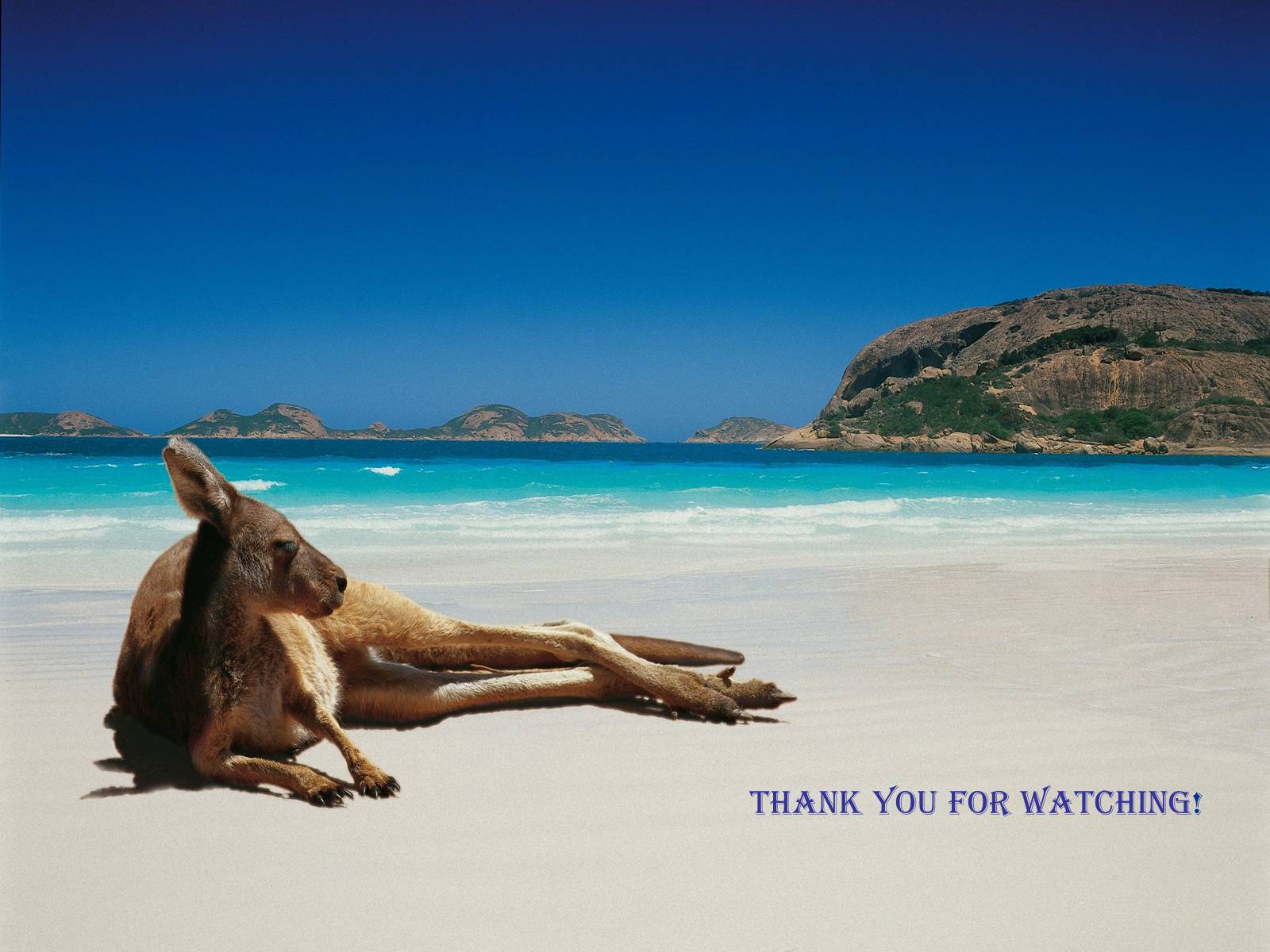- Головна
- Готові шкільні презентації
- Презентація на тему «Australia» (варіант 6)
Презентація на тему «Australia» (варіант 6)
241
Слайд #1
Australian history is almost always picturesque; It does not read like history, but like the most beautiful of lies. And all of a fresh new sort, no mouldy old stale ones. It is full of surprises, and adventures, and incongruities, and contradictions, and incredibilities ;
Mark Twain
Mark Twain
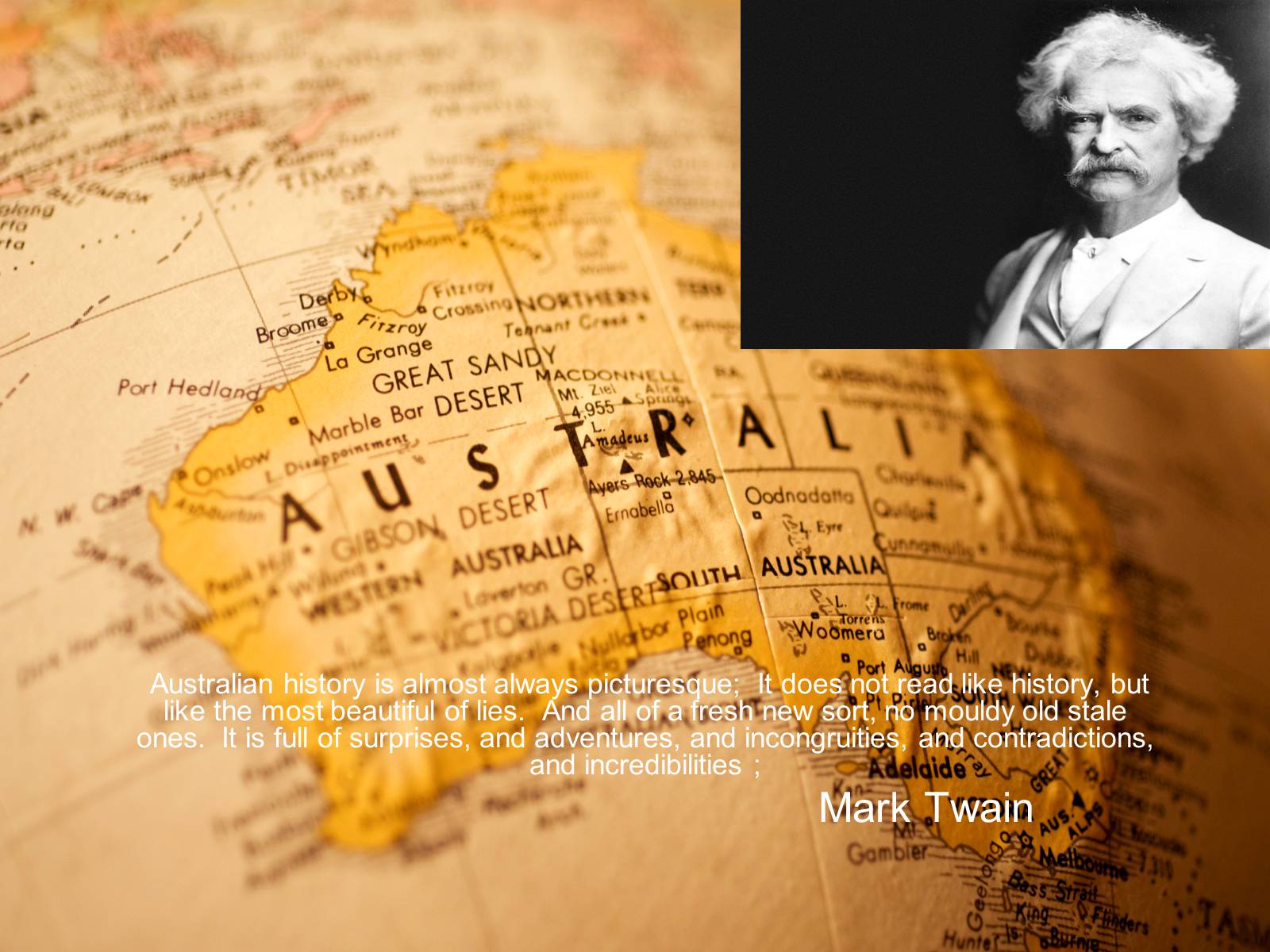
Слайд #2
Plan
Early History
The Name of Australia
The Discovery of Australia
The "First Fleet"
A Government Policy of “Assimilation“
Recherche Bay
Convicts and Free Settlers
Irish Convicts
The Foundation of Modern Australia
A Gold Rush
The Modern Australia
World War I
ANZUS
Early History
The Name of Australia
The Discovery of Australia
The "First Fleet"
A Government Policy of “Assimilation“
Recherche Bay
Convicts and Free Settlers
Irish Convicts
The Foundation of Modern Australia
A Gold Rush
The Modern Australia
World War I
ANZUS
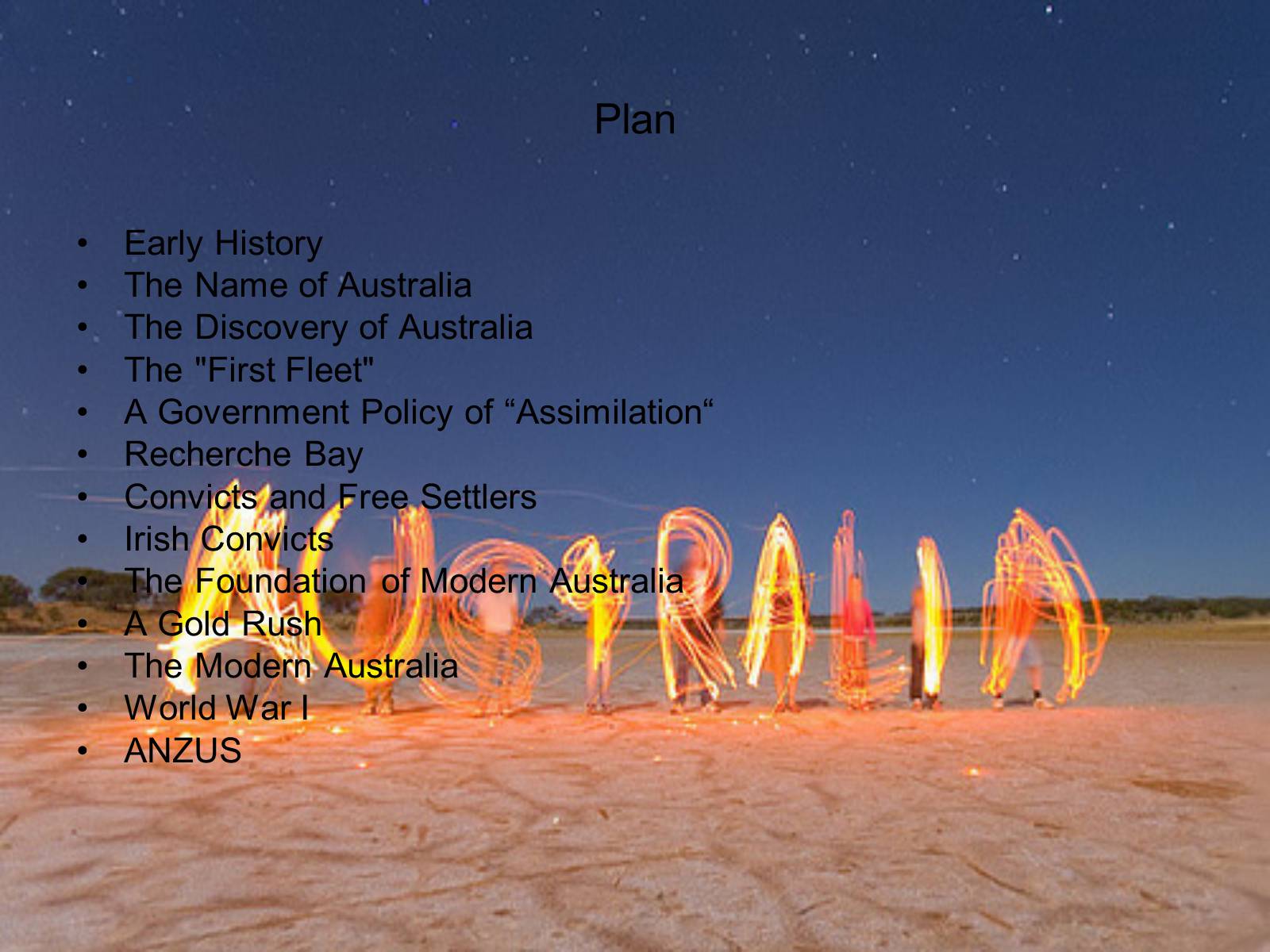
Слайд #3
Early History
According to the fossil record the first humans moved south 70 000 years ago from New Guinea. These humans where known as ‘Robust' due to their heavy-boned physical form.20 000 years later, they were followed by the more slender-boned ‘Gracile' ,the ancestors of the modern day Aborigines. Complicating the scientific record is the discovery of Mungo Man,a primate whose ritually-buried remains from 62 000 years ago have been found, but whose DNA can't be categorised into any line of human evolution.
It is not clear why the Gracile race became dominant over the Robust race and why Mungo Man disappeared altogether Perhaps there was war, perhaps there was disease or perhaps the Gracile bred the others out of existence.
According to the fossil record the first humans moved south 70 000 years ago from New Guinea. These humans where known as ‘Robust' due to their heavy-boned physical form.20 000 years later, they were followed by the more slender-boned ‘Gracile' ,the ancestors of the modern day Aborigines. Complicating the scientific record is the discovery of Mungo Man,a primate whose ritually-buried remains from 62 000 years ago have been found, but whose DNA can't be categorised into any line of human evolution.
It is not clear why the Gracile race became dominant over the Robust race and why Mungo Man disappeared altogether Perhaps there was war, perhaps there was disease or perhaps the Gracile bred the others out of existence.
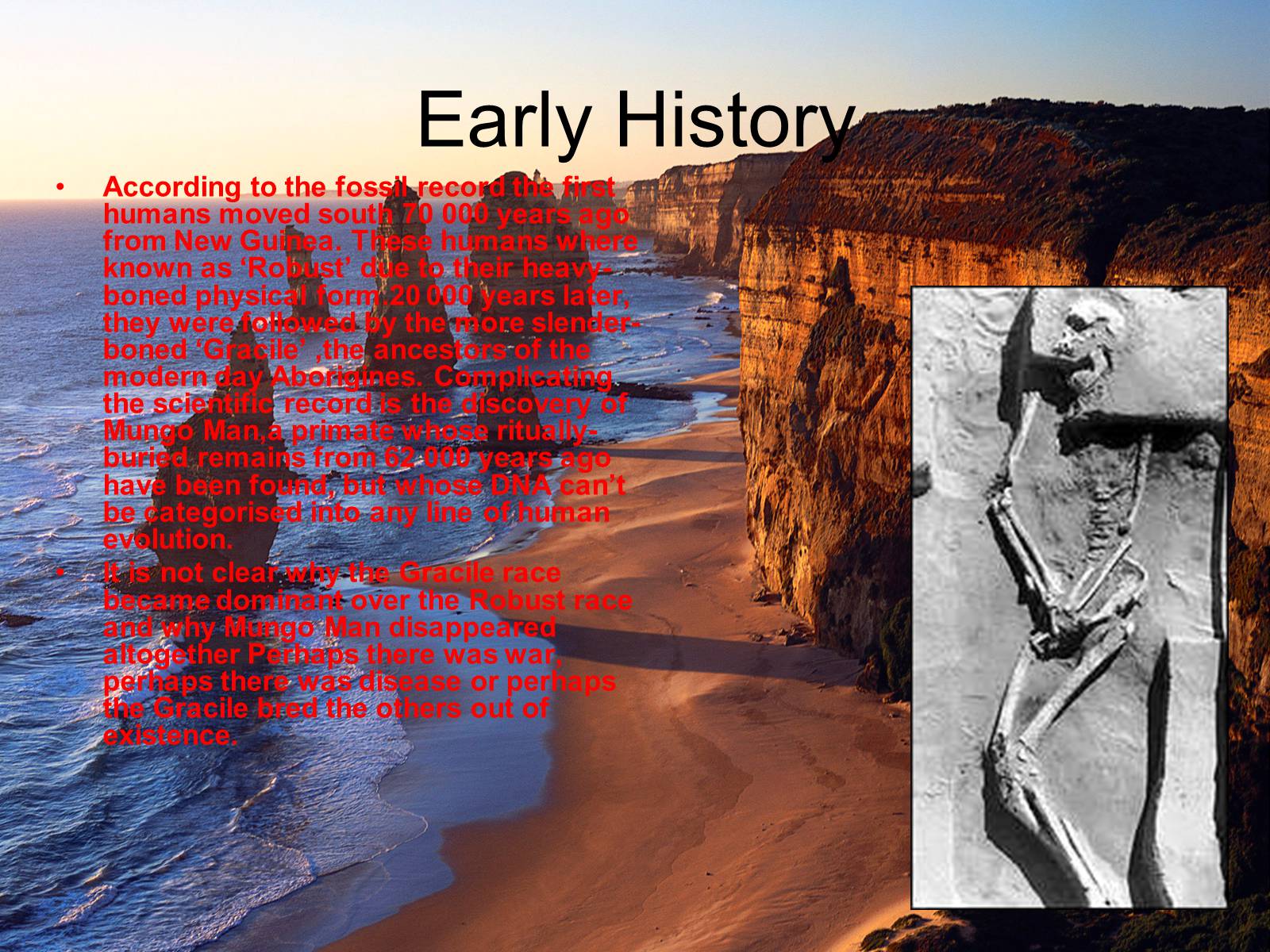
Слайд #4
Early History
The greatest population density for Aborigines developed in the southern and eastern regions, the River Murray valley in particular.
"Firestick farming" amongst northern Australian people was used to encourage plant growth that attracted animals.
The greatest population density for Aborigines developed in the southern and eastern regions, the River Murray valley in particular.
"Firestick farming" amongst northern Australian people was used to encourage plant growth that attracted animals.
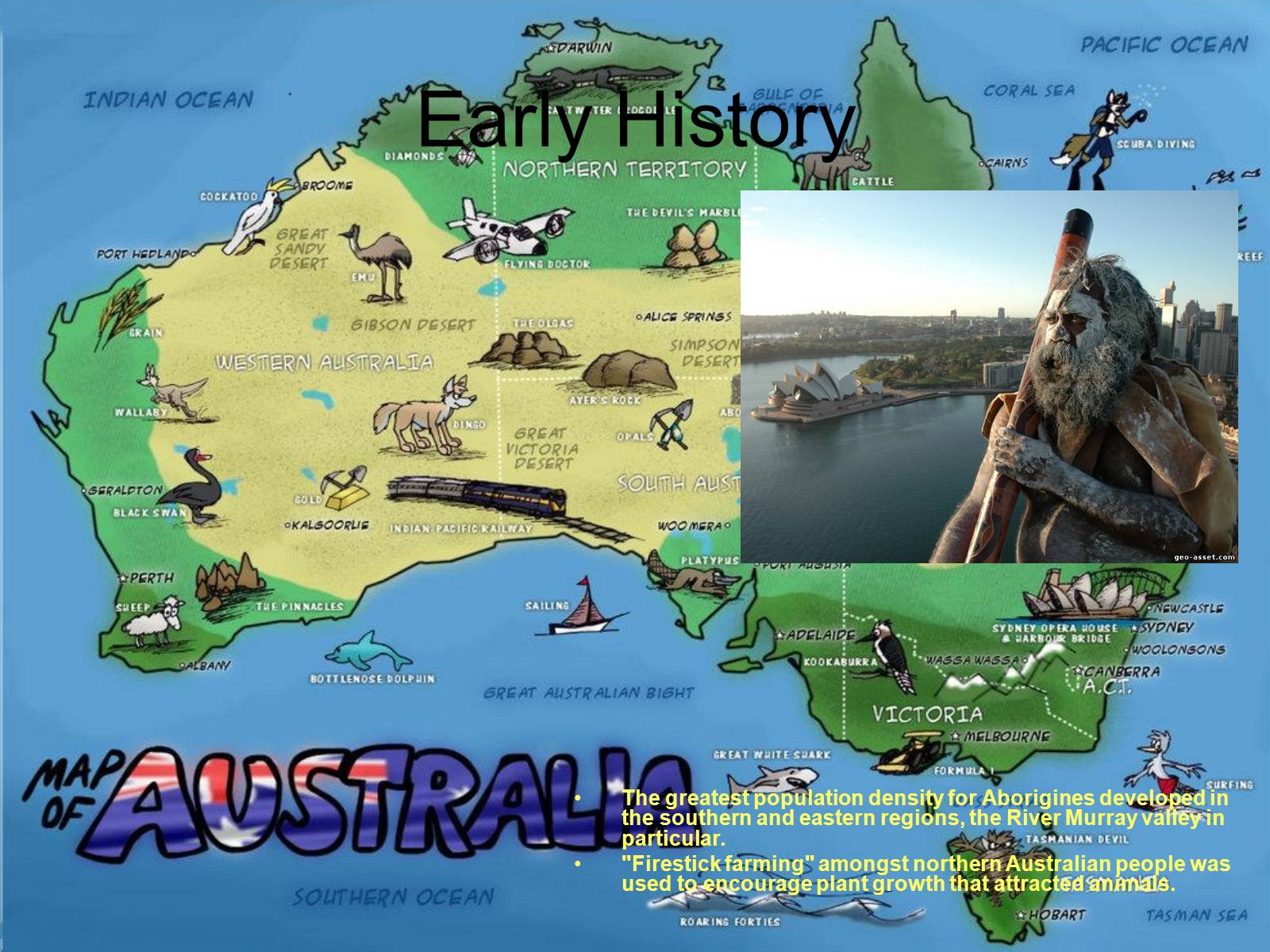
Слайд #5
The Name of Australia
The name Australia is derived from the Latin australis, meaning "southern". The country has been referred to colloquially as Oz since the early 20th century. Aussie is a common colloquial term for "Australian".
Legends of Terra Australis Incognita—an "unknown land of the South"—date back to Roman times and were commonplace in medieval geography, although not based on any documented knowledge of the continent. Following European discovery, names for the Australian landmass were often references to the famed Terra Australis.
The name Australia is derived from the Latin australis, meaning "southern". The country has been referred to colloquially as Oz since the early 20th century. Aussie is a common colloquial term for "Australian".
Legends of Terra Australis Incognita—an "unknown land of the South"—date back to Roman times and were commonplace in medieval geography, although not based on any documented knowledge of the continent. Following European discovery, names for the Australian landmass were often references to the famed Terra Australis.
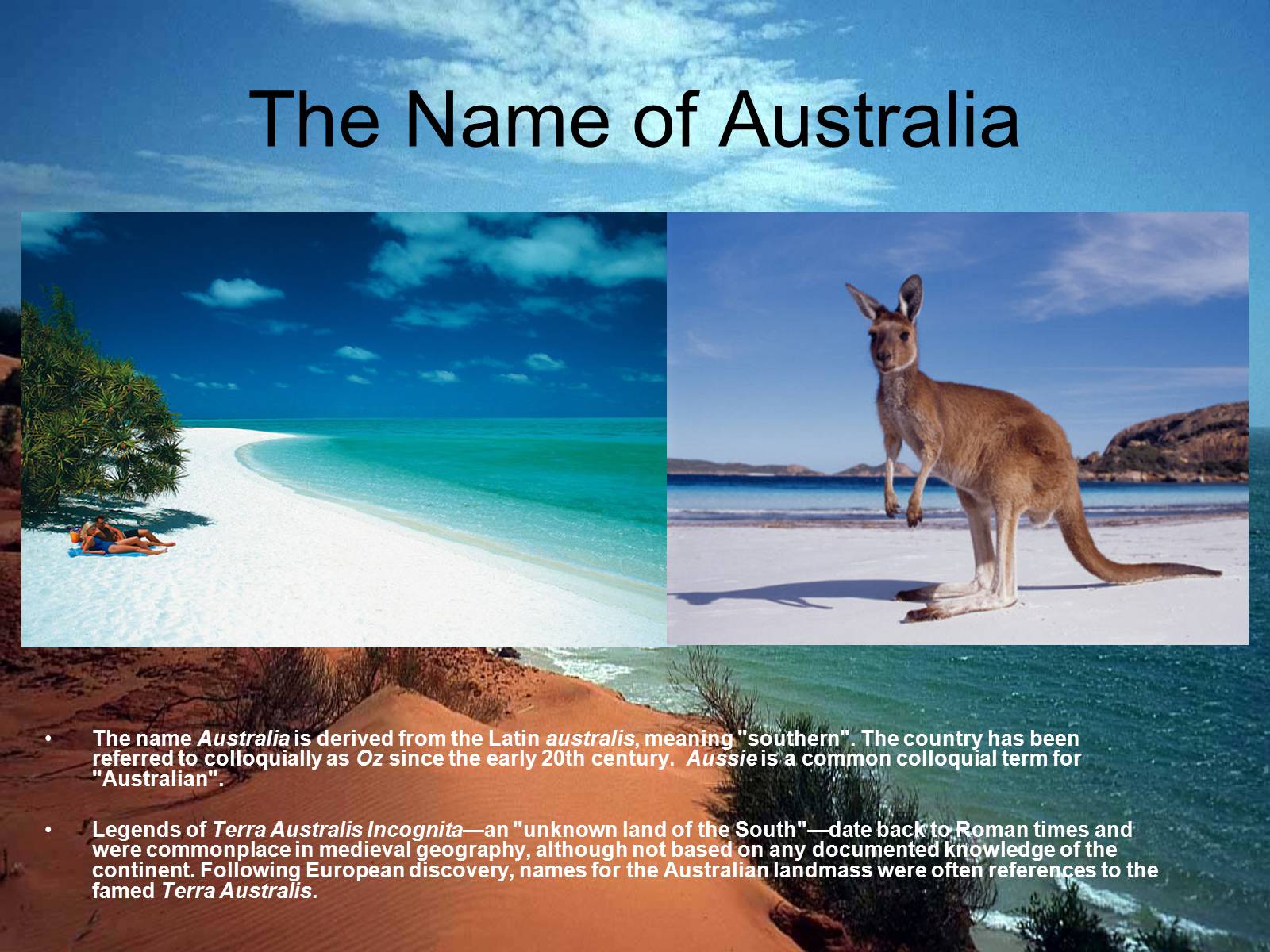
Слайд #6
The Discovery of Australia
The first recorded European landfall on the Australian continent, are attributed to the Dutch navigator Willem Janszoon.
The Dutch charted the whole of the western and northern coastlines and named the island continent "New Holland".
William Dampier, an English explorer landed on the north-west coast of New Holland in 1688 and again in 1699 on a return trip.
The first recorded European landfall on the Australian continent, are attributed to the Dutch navigator Willem Janszoon.
The Dutch charted the whole of the western and northern coastlines and named the island continent "New Holland".
William Dampier, an English explorer landed on the north-west coast of New Holland in 1688 and again in 1699 on a return trip.
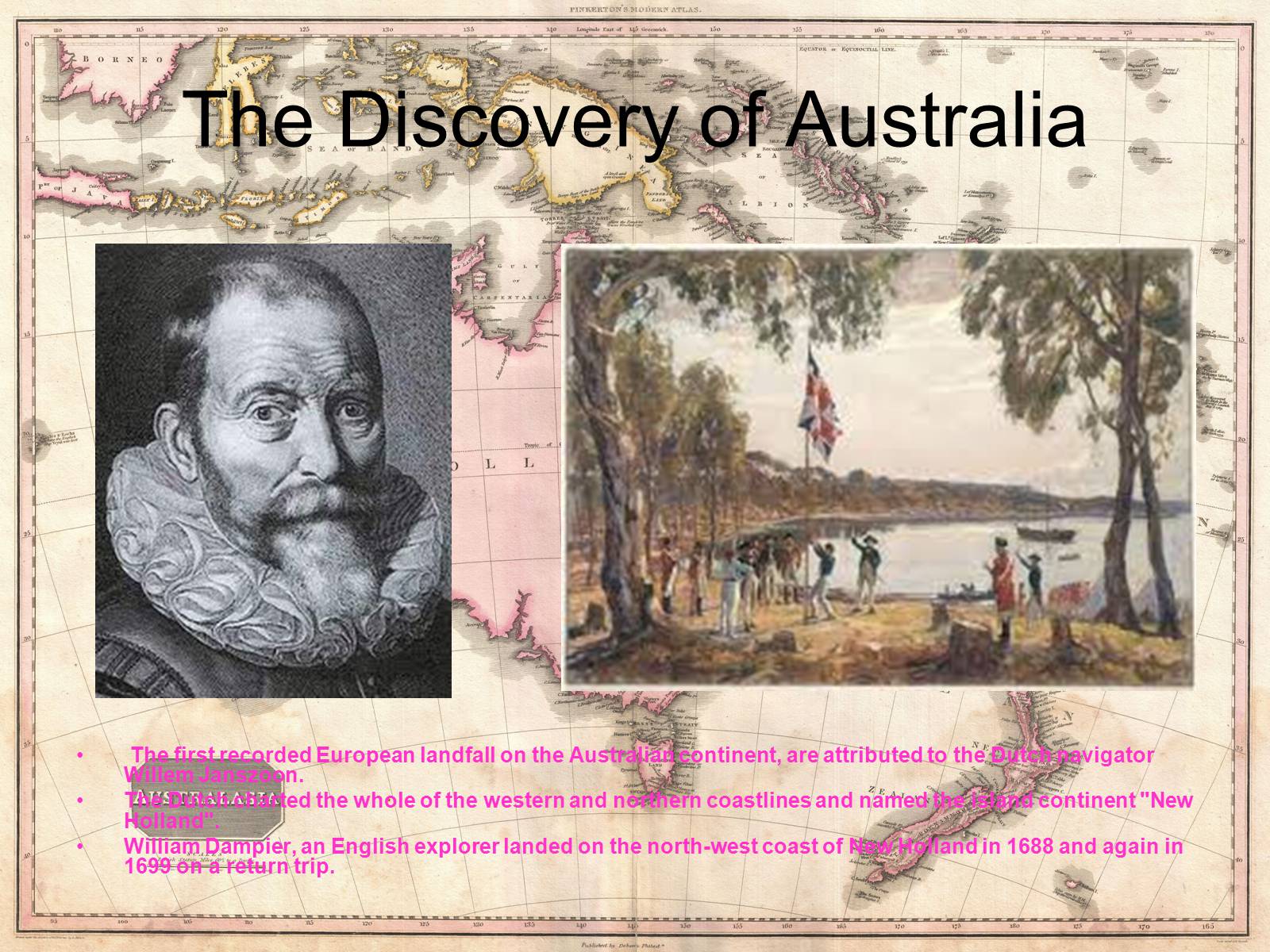
Слайд #7
The "First Fleet"
In 1770, James Cook sailed along and mapped the east coast, which he named New South Wales and claimed for Great Britain. In 1780, the British Government sent a fleet of ships, the "First Fleet", under the command of Captain Arthur Phillip, to establish a new penal colony in New South Wales.
The first settlement led to the foundation of Sydney, the establishment of farming, industry and commerce; and the exploration and settlement of other regions.
In 1770, James Cook sailed along and mapped the east coast, which he named New South Wales and claimed for Great Britain. In 1780, the British Government sent a fleet of ships, the "First Fleet", under the command of Captain Arthur Phillip, to establish a new penal colony in New South Wales.
The first settlement led to the foundation of Sydney, the establishment of farming, industry and commerce; and the exploration and settlement of other regions.
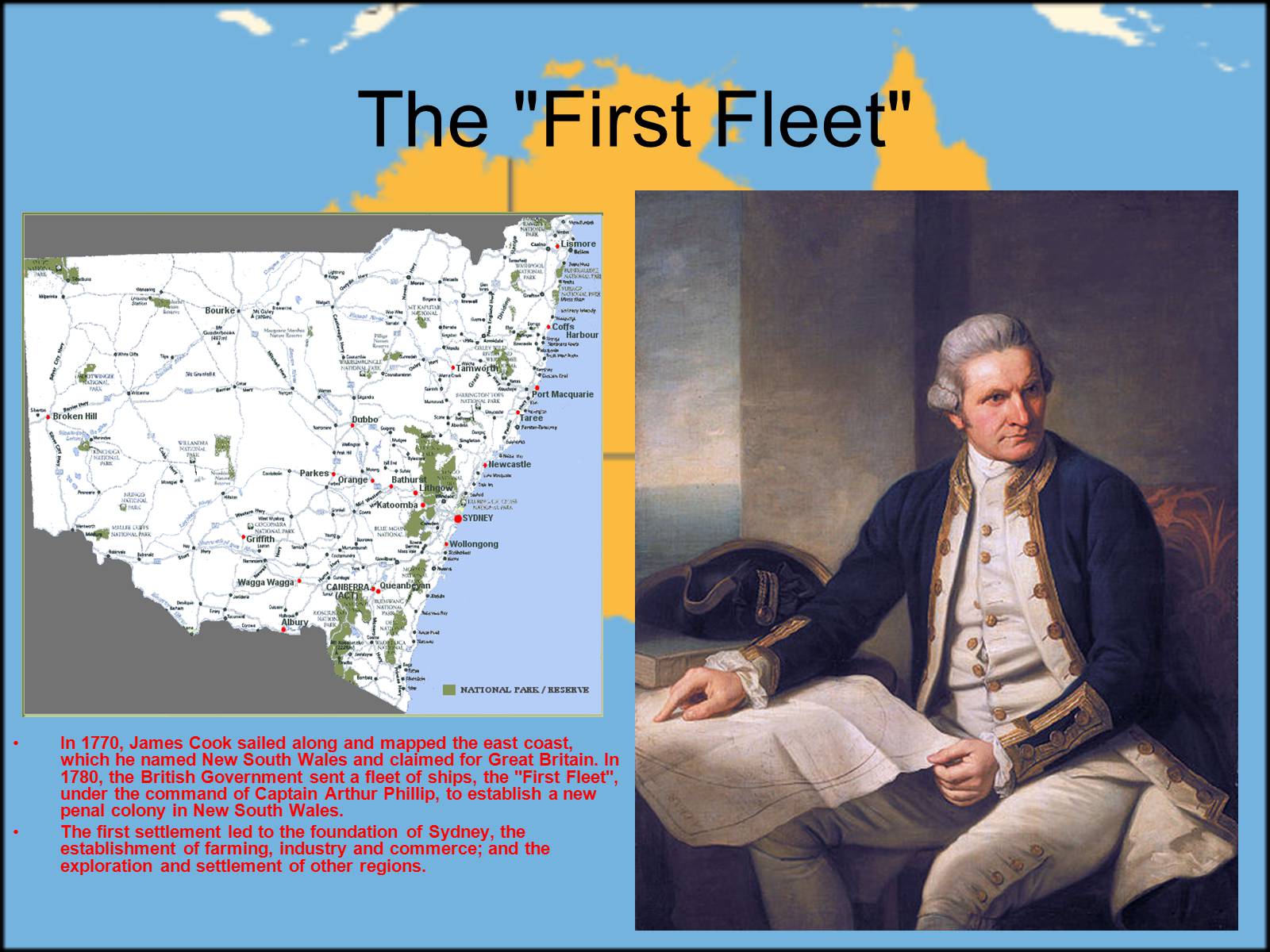
Слайд #8
A Government Policy of “Assimilation"
The indigenous population, estimated to have been between 750,000 and 1,000,000 at the time European settlement began,declined for 150 years following settlement, mainly due to infectious disease. A government policy of "assimilation" beginning with the Aboriginal Protection Act 1869 resulted in the removal of many Aboriginal children from their families and communities— often referred to as the Stolen Generations— a practice which may also have contributed to the decline in the indigenous population. The Federal government gained the power to make laws with respect to Aborigines following the 1967 referendum.
The indigenous population, estimated to have been between 750,000 and 1,000,000 at the time European settlement began,declined for 150 years following settlement, mainly due to infectious disease. A government policy of "assimilation" beginning with the Aboriginal Protection Act 1869 resulted in the removal of many Aboriginal children from their families and communities— often referred to as the Stolen Generations— a practice which may also have contributed to the decline in the indigenous population. The Federal government gained the power to make laws with respect to Aborigines following the 1967 referendum.
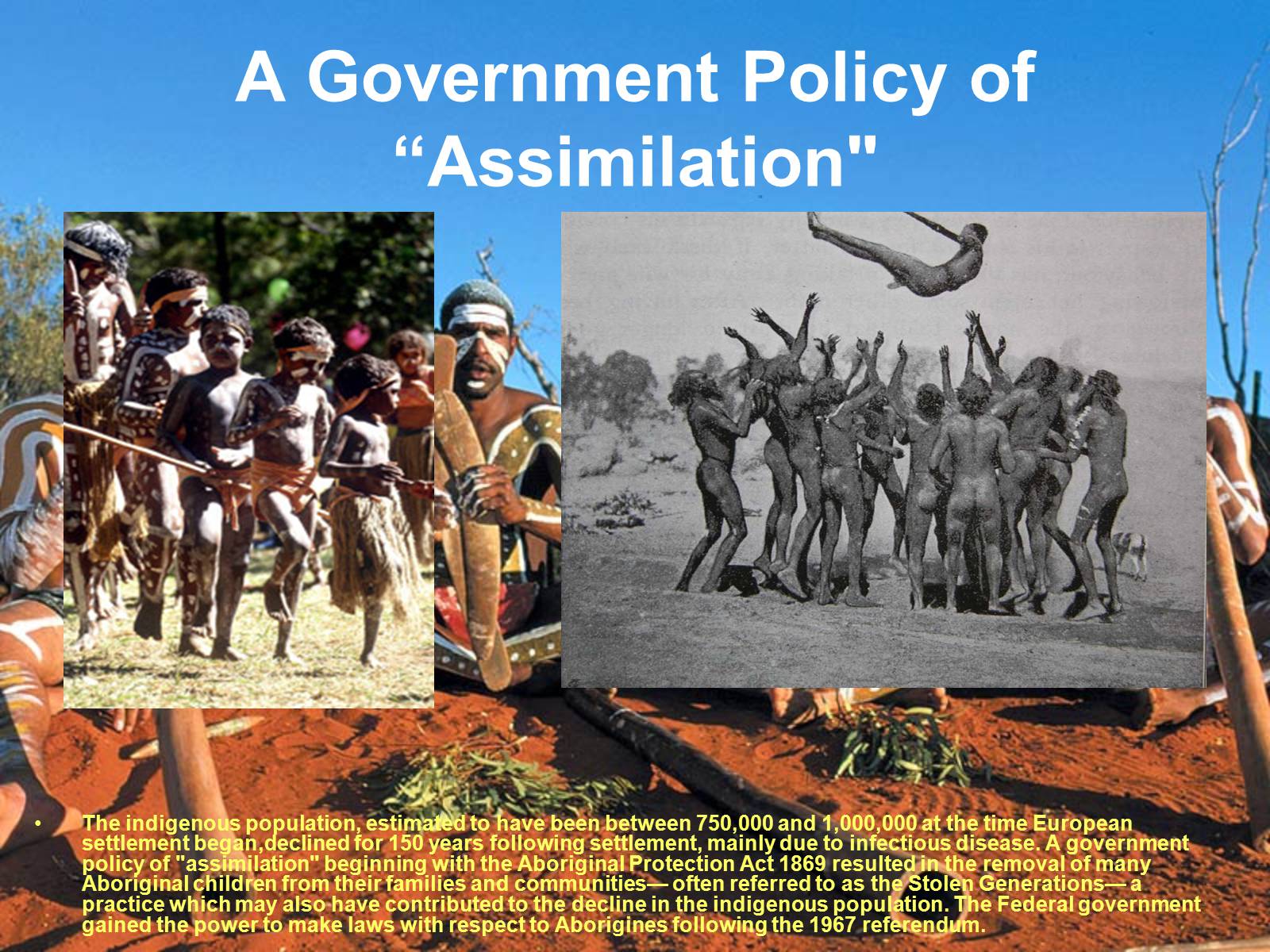
Слайд #9
Recherche Bay
In 1792, two French ships, La Recherche and L'Espérance anchored in a harbour near Tasmania's southernmost point they called Recherche Bay.
In 1792, two French ships, La Recherche and L'Espérance anchored in a harbour near Tasmania's southernmost point they called Recherche Bay.
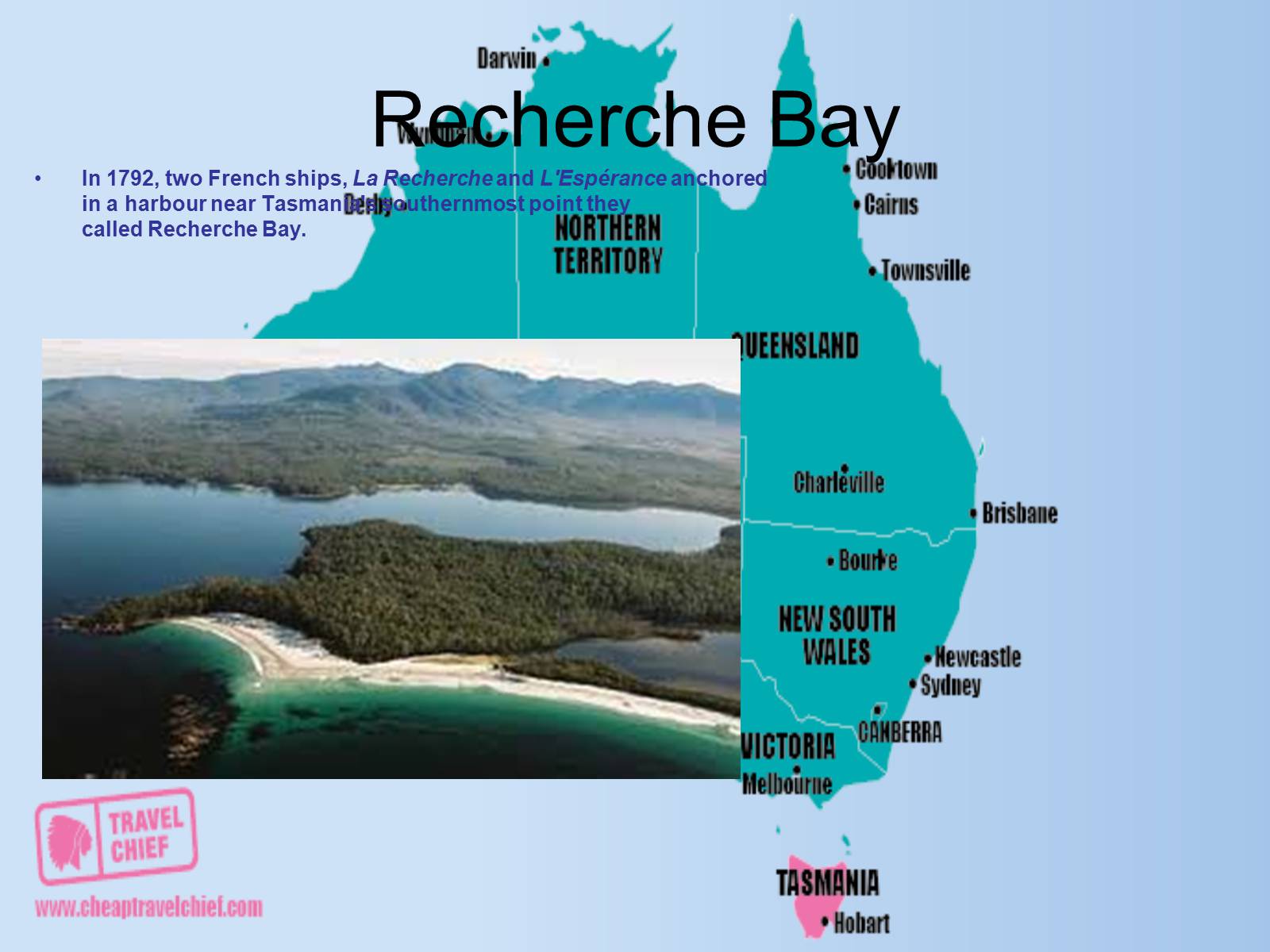
Слайд #10
Convicts and free settlers
When the Bellona transport came to anchor in Sydney Cove on 16 January 1793, she brought with her the first immigrant free settlers.
When the Bellona transport came to anchor in Sydney Cove on 16 January 1793, she brought with her the first immigrant free settlers.
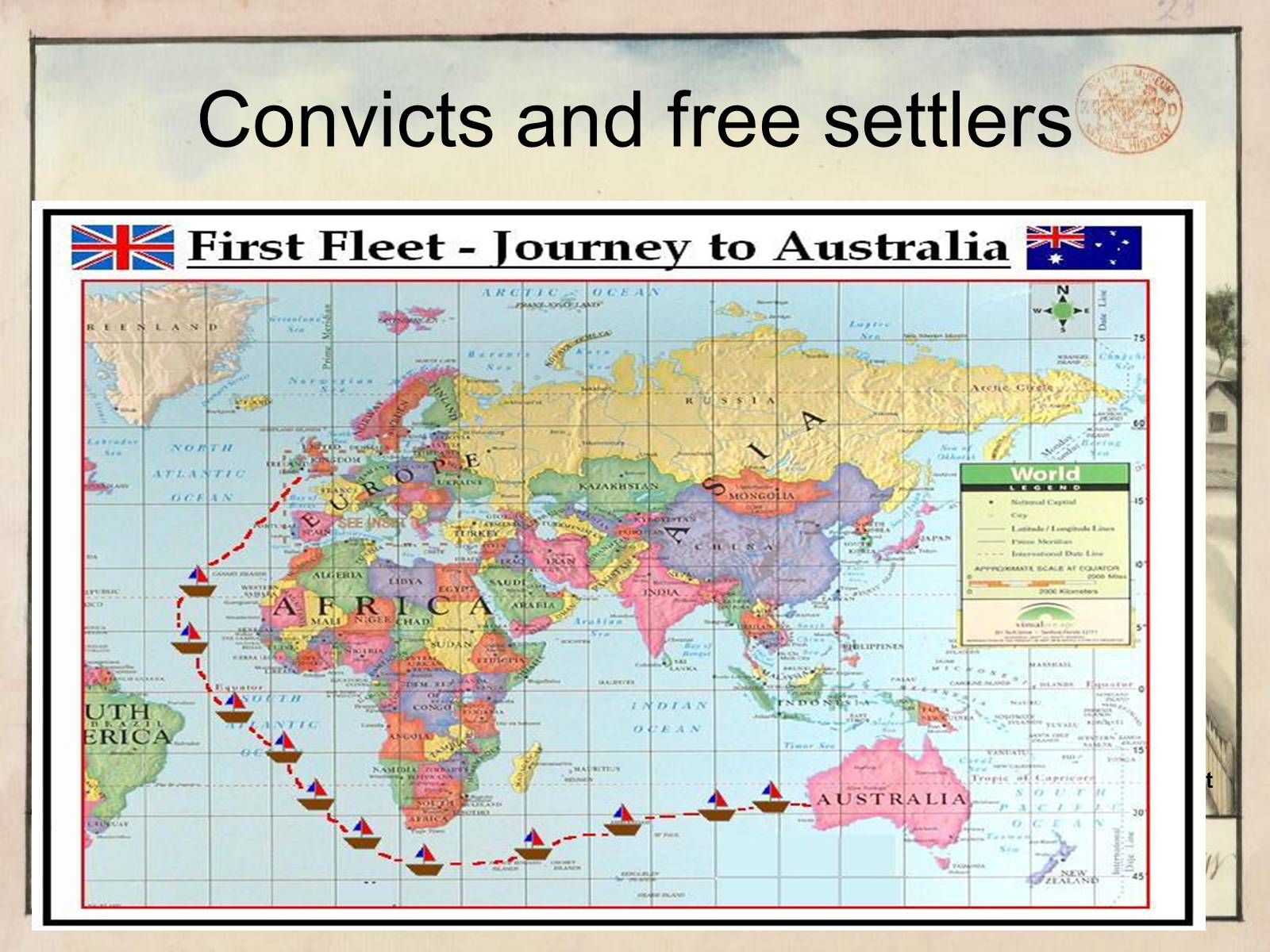
Слайд #11
Irish Convicts
One in three convicts transported after 1798 was Irish, about a fifth of whom were transported in connection with the political and agrarian disturbances common in Ireland at the time.
One in three convicts transported after 1798 was Irish, about a fifth of whom were transported in connection with the political and agrarian disturbances common in Ireland at the time.
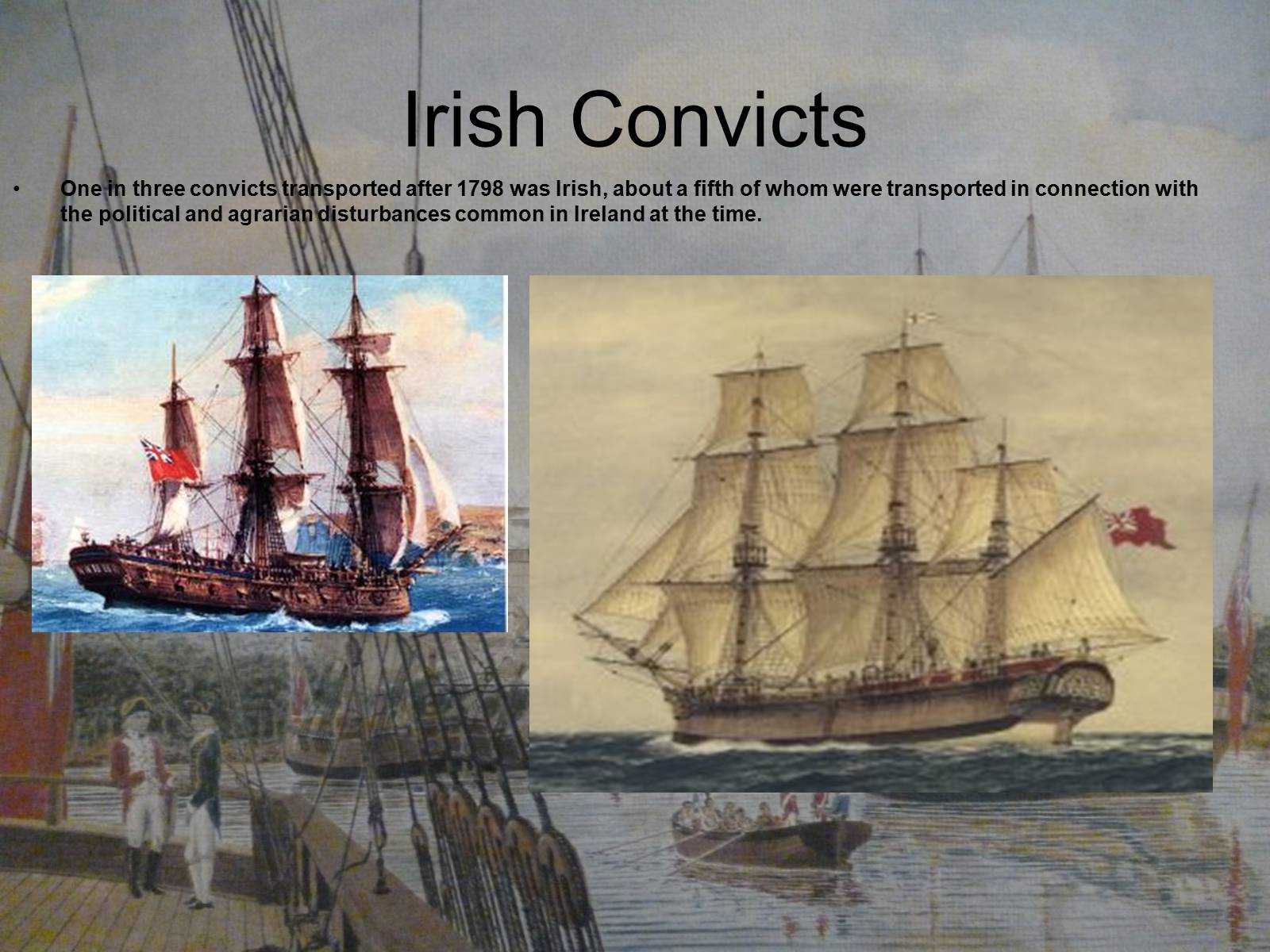
Слайд #12
A British settlement was established in Van Diemen's Land, now known as Tasmania, in 1803 and it became a separate colony in 1825.
Separate colonies were carved from parts of New South Wales: South Australia in 1836, Victoria in 1851, and Queensland in 1859.
South Australia was founded as a "free province"—it was never a penal colony. Victoria and Western Australia were also founded "free", but later accepted transported convicts.
21 January 1827 – Western Australia was established when a small British settlement was established at King George's Sound (Albany) by Major Edmund Lockyer who was to provide a deterrent to the French presence in the area.
1835 – the Proclamation of Governor Bourke, issued by the Colonial Office and sent to the Governor with Despatch 99 of 10 October 1835, implements the doctrine of terra nullius upon which British settlement was based.
28 December 1836 – the British province of South Australia was established. In 1842 it became a crown colony and on 22 July 1861 its area was extended westwards to its present boundary and more area was taken from New South Wales.
1841 – New Zealand is separated from New South Wales.
1851 – Victoria is separated from New South Wales.
10 December 1859 – Queensland is separated from New South Wales.
23 December 1862 – the area of Queensland is increased.
1863 – control of the Northern Territory is granted to the Province (later State) of South Australia. In 1825 the area occupied today by Northern Territory was incorporated into the colony of New South Wales.
The Foundation of Modern Australia
Separate colonies were carved from parts of New South Wales: South Australia in 1836, Victoria in 1851, and Queensland in 1859.
South Australia was founded as a "free province"—it was never a penal colony. Victoria and Western Australia were also founded "free", but later accepted transported convicts.
21 January 1827 – Western Australia was established when a small British settlement was established at King George's Sound (Albany) by Major Edmund Lockyer who was to provide a deterrent to the French presence in the area.
1835 – the Proclamation of Governor Bourke, issued by the Colonial Office and sent to the Governor with Despatch 99 of 10 October 1835, implements the doctrine of terra nullius upon which British settlement was based.
28 December 1836 – the British province of South Australia was established. In 1842 it became a crown colony and on 22 July 1861 its area was extended westwards to its present boundary and more area was taken from New South Wales.
1841 – New Zealand is separated from New South Wales.
1851 – Victoria is separated from New South Wales.
10 December 1859 – Queensland is separated from New South Wales.
23 December 1862 – the area of Queensland is increased.
1863 – control of the Northern Territory is granted to the Province (later State) of South Australia. In 1825 the area occupied today by Northern Territory was incorporated into the colony of New South Wales.
The Foundation of Modern Australia
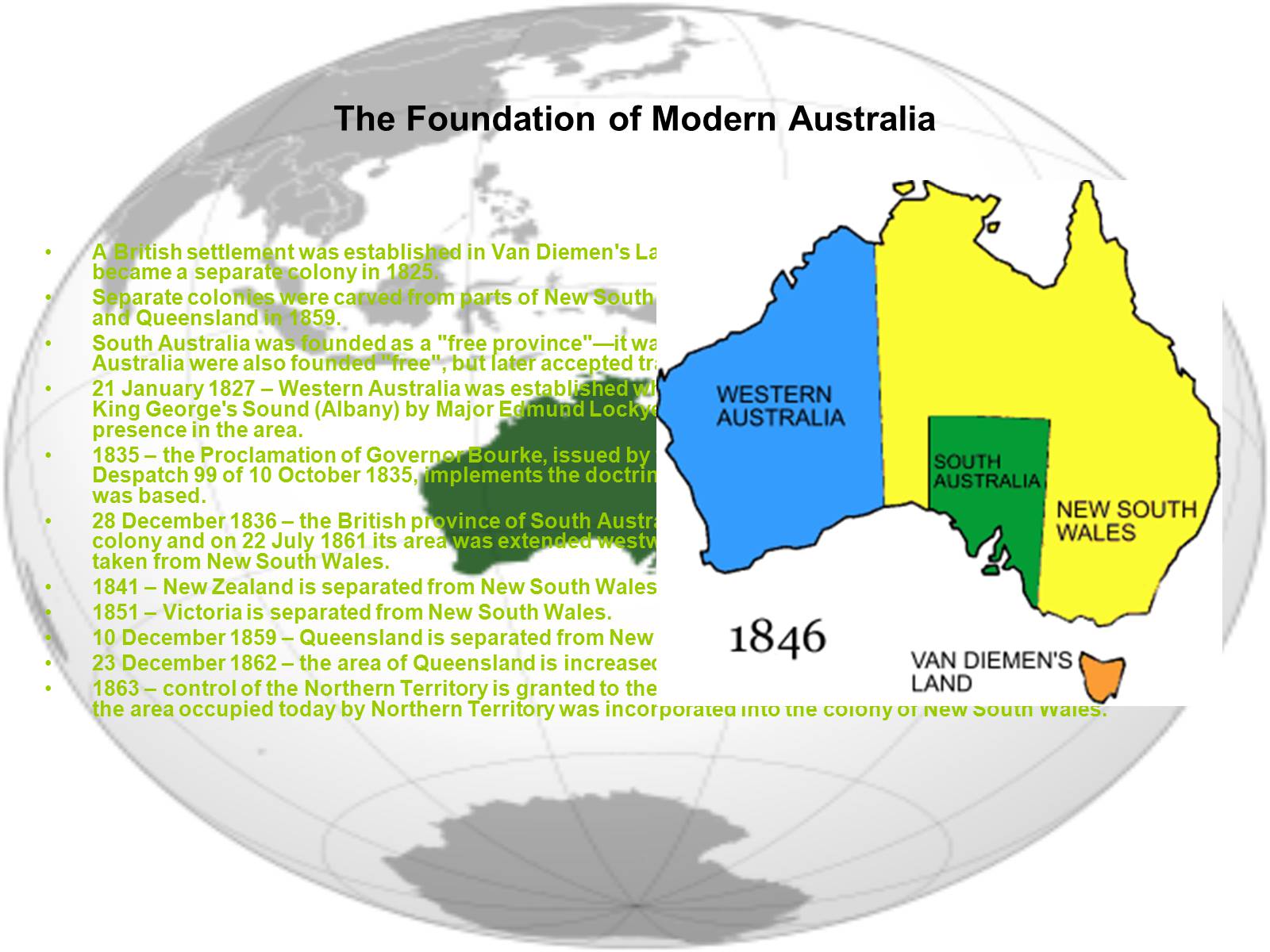
Слайд #13
A Gold Rush
A gold rush began in Australia in the early 1850s and the Eureka Rebellion against mining licence fees in 1854 was an early expression of civil disobedience .Between 1855 and 1890, the six colonies individually gained responsible government, managing most of their own affairs while remaining part of the British Empire. The Colonial Office in London retained control of some matters, notably foreign affairs,defence, and international shipping.
A gold rush began in Australia in the early 1850s and the Eureka Rebellion against mining licence fees in 1854 was an early expression of civil disobedience .Between 1855 and 1890, the six colonies individually gained responsible government, managing most of their own affairs while remaining part of the British Empire. The Colonial Office in London retained control of some matters, notably foreign affairs,defence, and international shipping.
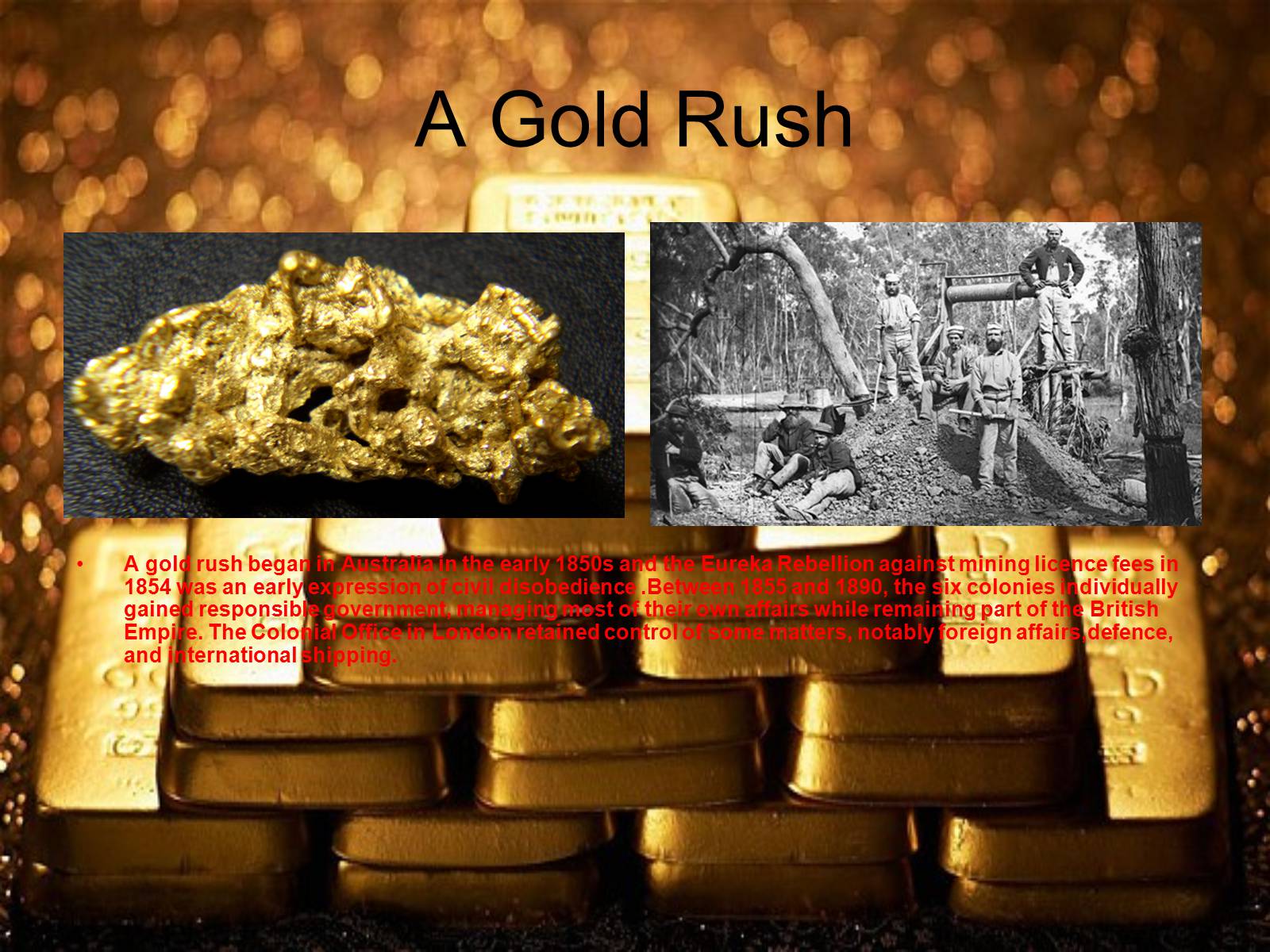
Слайд #14
The Modern Australia
Melbourne, Victoria.
On 1 January 1901, federation of the colonies was achieved after a decade of planning, consultation and voting. The Commonwealth of Australia was established and it became a dominion of the British Empire in 1907.
Melbourne, Victoria.
On 1 January 1901, federation of the colonies was achieved after a decade of planning, consultation and voting. The Commonwealth of Australia was established and it became a dominion of the British Empire in 1907.
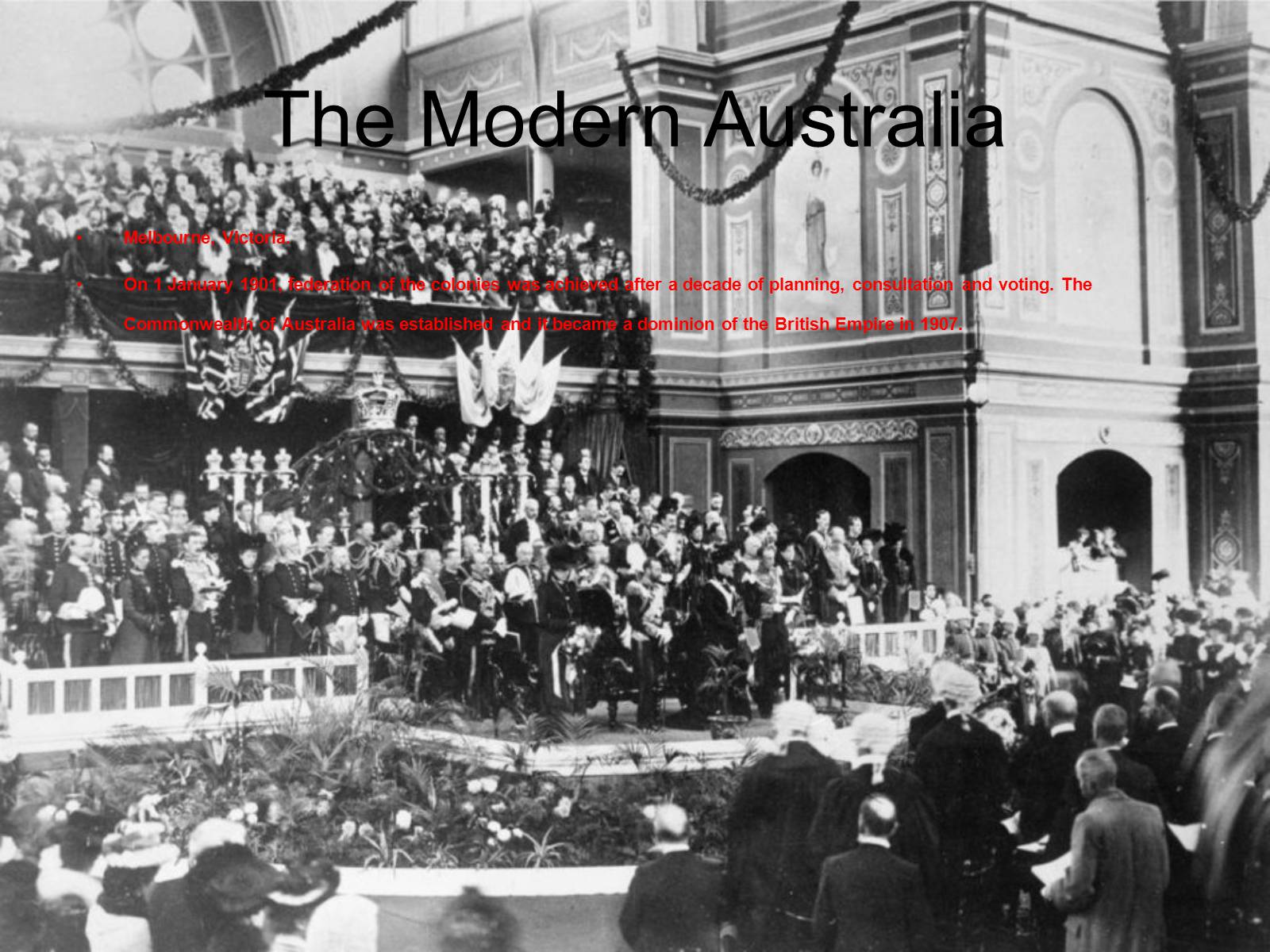
Слайд #15
World War I
In 1914, Australia joined Britain in fighting World War I, with support from both the outgoing Commonwealth Liberal Party and the incoming Australian Labor Party. Australians took part in many of the major battles fought on the Western Front.
In 1914, Australia joined Britain in fighting World War I, with support from both the outgoing Commonwealth Liberal Party and the incoming Australian Labor Party. Australians took part in many of the major battles fought on the Western Front.
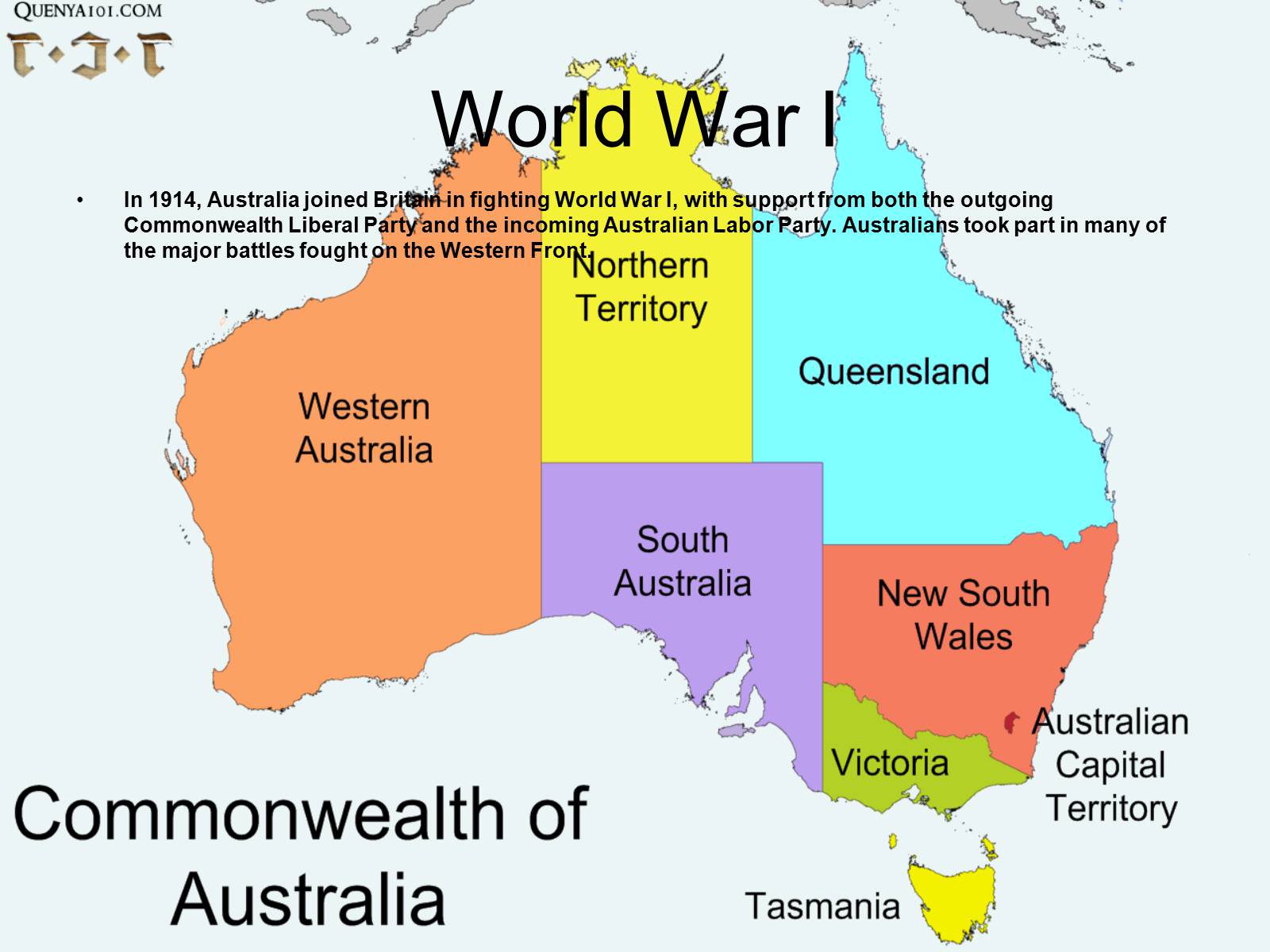
Слайд #16
ANZUS
Since 1951, Australia has been a formal military ally of the US, under the ANZUS treaty. 1939-1945 World War II: Anzac troops in Greece, Crete, and N-Africa (El Alamein) and the Pacific. The Japanese bomb Darwin in 1942.
After World War II Australia encouraged immigration from Europe. Since the 1970s and following the abolition of the White Australia policy, immigration from Asia and elsewhere was also promoted. As a result, Australia's demography, culture, and self-image were transformed.
Since 1951, Australia has been a formal military ally of the US, under the ANZUS treaty. 1939-1945 World War II: Anzac troops in Greece, Crete, and N-Africa (El Alamein) and the Pacific. The Japanese bomb Darwin in 1942.
After World War II Australia encouraged immigration from Europe. Since the 1970s and following the abolition of the White Australia policy, immigration from Asia and elsewhere was also promoted. As a result, Australia's demography, culture, and self-image were transformed.
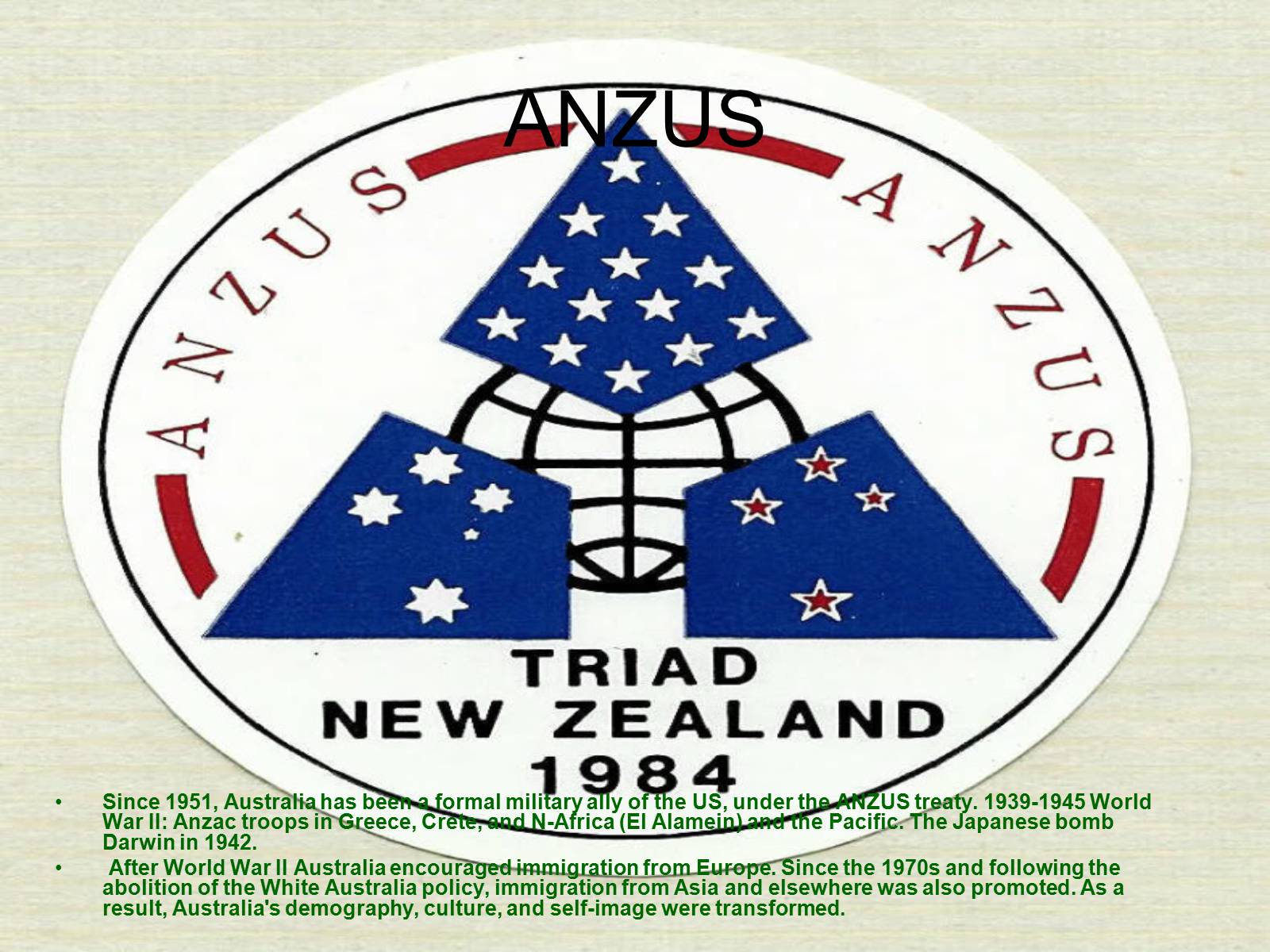
Слайд #17
The final constitutional ties between Australia and the UK were severed with the passing of the Australia Act 1986, ending any British role in the government of the Australian States, and closing the option of judicial appeals to the Privy Council in London.
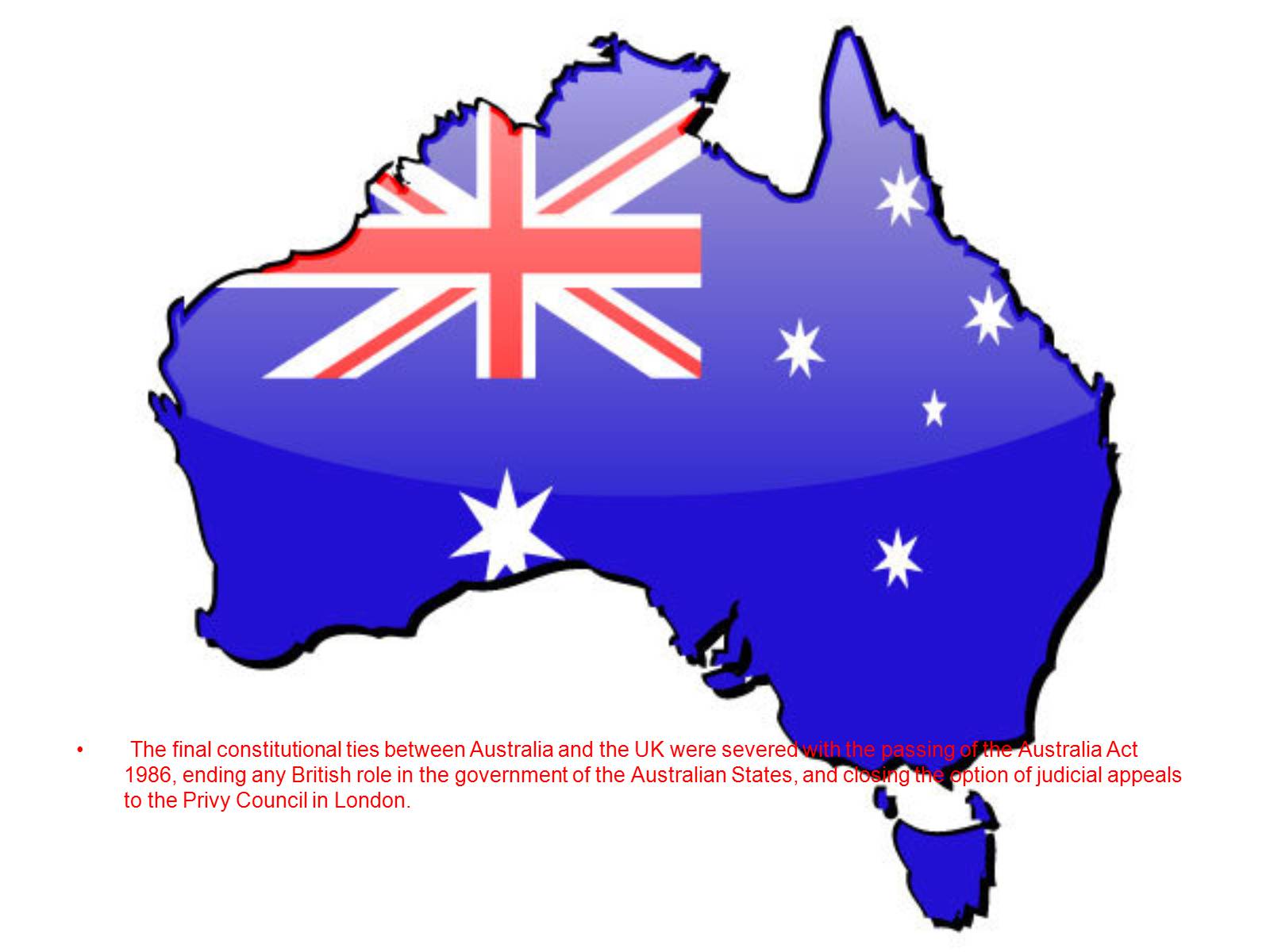
Слайд #18
Thank you for watching!
